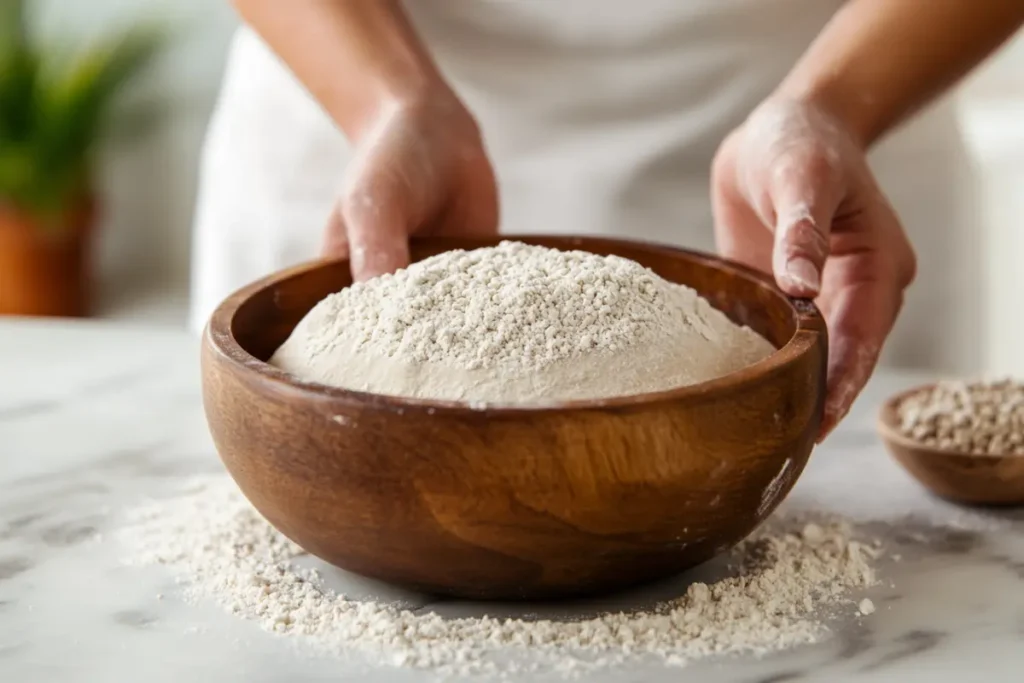Bagels—chewy, golden, and utterly delicious—are a breakfast staple worldwide. But have you ever wondered, what is the most important ingredient in bagels? Is it the flour, the water, the yeast, or perhaps the unique boiling process that sets them apart from other bread?
This article takes a deep dive into the essential ingredients that make a bagel truly great. We’ll explore the science behind flour, the role of water chemistry, the magic of yeast fermentation, and why bagels are boiled before baking. By the end, you’ll know exactly which ingredient is the most crucial and why.
Let’s get started!
Introduction to Bagels and Their Key Ingredients
Bagels may seem simple, but getting that perfect chewy texture and crisp crust requires precision. The foundation of any bagel is a handful of essential ingredients: flour, water, yeast, salt, and sometimes sugar or malt syrup. While these components are basic, how they interact creates the bagel’s signature bite and flavor.
The Origin of Bagels and Their Popularity
Bagels trace their roots back to Poland in the 17th century, where they were a favorite among Jewish communities. Over time, these ring-shaped delights made their way to the United States, especially New York, where they became legendary. Today, bagels are a global phenomenon, but New York-style bagels remain the gold standard, thanks to their chewy interior and slightly crisp crust.
The Simple Yet Essential Ingredients of a Bagel
At its core, a bagel contains just a few basic ingredients:
- Flour: Typically high-protein bread flour for a strong gluten structure.
- Water: Hydrates the dough and affects texture—New York’s water is often credited for superior bagels.
- Yeast: Helps the dough rise and develops flavor during fermentation.
- Salt: Enhances flavor and strengthens the gluten network.
- Sweeteners (optional): Some recipes use malt syrup, honey, or sugar for a slight sweetness and better browning.
Why One Ingredient Stands Out as the Most Important
All ingredients play a role, but if you remove one, would the bagel still work? That’s the key question. Over the next sections, we’ll examine each ingredient’s role in detail before answering: what is the most important ingredient in bagels? Stay tuned!
What is the Most Important Ingredient in Bagels?The Role of Flour – The Heart of Every Bagel

Why Bread Flour is Essential for Bagels
If there’s one ingredient bagels can’t do without, it’s flour. Specifically, high-protein bread flour is the secret behind the classic chewiness that sets bagels apart from regular bread. This type of flour contains more gluten-forming proteins, giving bagels their strong structure and dense bite.
Unlike all-purpose flour, which has a protein content of about 10-12%, bread flour contains 12-14%. The extra protein means more gluten, and gluten gives bagels that delightful elasticity. Without it, bagels would be too soft and lack their characteristic chew.
The Science Behind Gluten and Chewiness
When you mix flour with water, proteins called glutenin and gliadin form gluten, a stretchy network that traps air and holds the dough together. Kneading the dough strengthens this network, making it even more elastic.
In bagels, a strong gluten network is essential because:
- It creates a dense, chewy interior.
- It helps bagels hold their round shape.
- It withstands the boiling process without falling apart.
This is why bagel recipes almost always call for bread flour—without it, you’d get something closer to a roll than a true bagel!
How Different Types of Flour Affect the Final Product
While bread flour is the gold standard for bagels, some bakers experiment with different types:
- All-Purpose Flour: Produces softer, less chewy bagels.
- Whole Wheat Flour: Adds fiber and a nutty flavor but makes a denser bagel.
- Gluten-Free Flour: Creates a bagel alternative but lacks the signature chew.
For the best bagel experience, high-protein flour is non-negotiable. It’s the foundation of every great bagel, making it a top contender for the most important ingredient in bagels.
Water – The Secret Behind Authentic Bagel Texture
The Unique Impact of Water on Bagel Dough
Ever heard the myth that New York water makes the best bagels? There’s actually some truth to it! Water plays a crucial role in dough hydration and gluten development, affecting the final texture of the bagel.
Water helps control:
- Hydration Levels: Too much water makes dough sticky; too little makes it dry and tough.
- Gluten Strength: Proper hydration allows gluten to form correctly, leading to a chewy bite.
- Mineral Content: Certain minerals can strengthen gluten, affecting texture.
Bagel makers often adjust hydration levels based on local water conditions to get the perfect dough consistency.
Does New York Water Really Make a Difference?
Many believe New York bagels are superior because of the city’s water. New York’s water is:
- Soft (low in minerals) – This results in a smoother, more elastic dough.
- Naturally filtered – It has a unique balance of minerals that affects fermentation.
However, while water can influence texture, it’s not the only factor. The flour, kneading process, and boiling step all play a significant role. That said, using the right water-to-flour ratio is essential for making an authentic bagel.
If you’re baking bagels at home and want to achieve that New York-style chewiness, consider using filtered or soft water. But no matter where you are, the right flour and technique will always be more important!
Yeast – The Power Behind the Rise
How Yeast Influences Bagel Flavor and Texture
Without yeast, bagels would be flat, dense, and lifeless. Yeast is a microorganism that consumes sugar and releases carbon dioxide (CO₂), which creates air pockets and allows the dough to rise. This process, known as fermentation, gives bagels their signature chew and slightly tangy taste.
Yeast doesn’t just make bagels rise—it also develops complex flavors. The longer the fermentation time, the richer and deeper the flavor. That’s why many bakers let their bagel dough rest overnight in the fridge. This slow fermentation enhances the dough’s taste while making the crust crispier when baked.
Instant Yeast vs. Active Dry Yeast – Which is Best?
Bagel recipes typically use one of two types of yeast:
- Active Dry Yeast: Needs to be dissolved in warm water before mixing with the dough. It works slower but produces excellent flavor.
- Instant Yeast: Can be mixed directly into the flour. It’s faster and more convenient but may not develop as much complexity in flavor.
While both work well, many bakers prefer active dry yeast for a traditional, robust bagel flavor. Whichever you choose, yeast is essential for creating bagels with the right rise and texture.
For a delicious variation, check out this Pumpkin Bagels Recipe and see how yeast works its magic with different flavors!
Boiling – The Step That Defines a Bagel

Why Bagels Are Boiled Before Baking
One of the biggest differences between bagels and other types of bread is boiling. This unique step gives bagels their dense texture and shiny crust. But why is it so important?
When bagels are dropped into boiling water before baking, the high heat:
- Sets the outer crust early, preventing the dough from expanding too much in the oven.
- Creates a chewy bite, as the quick heat locks in moisture.
- Develops a golden-brown exterior, especially when malt syrup or baking soda is added to the water.
Skipping the boiling step results in a softer, bread-like texture—something that just doesn’t feel like a real bagel!
How Malt, Honey, or Baking Soda in Boiling Water Affects Taste
Different bagel recipes call for additives in the boiling water, each influencing the crust and flavor:
- Malt Syrup: Adds a subtle sweetness and enhances browning.
- Honey: Provides a slightly floral taste with a mild caramelized crust.
- Baking Soda: Increases alkalinity, leading to a darker, shinier crust.
New York bagels are often boiled with malt syrup, giving them their signature golden hue and slight sweetness. Some bakers even use barley malt powder in the dough itself for extra depth of flavor.
Since boiling is essential to achieving the perfect bagel, some home bakers might wonder: Can you skip this step? The answer is no—if you want a real bagel, boiling is a must!
For more tips on achieving authentic bagel texture, check out Why Are American Bagels So Good?
The Supporting Ingredients – Sugar, Salt, and Beyond

The Role of Sugar in Dough Fermentation and Flavor
Though bagels aren’t as sweet as pastries, a small amount of sugar, honey, or malt syrup is often added to the dough. But why?
- Feeds the yeast: Sugar provides food for yeast fermentation, helping the dough rise properly.
- Enhances flavor: A touch of sweetness balances the bagel’s natural saltiness.
- Improves browning: Sugar caramelizes during baking, contributing to a deeper golden crust.
Traditional New York bagels use malt syrup instead of granulated sugar because it gives a subtle, rich sweetness without making the bagel taste sugary.
How Salt Affects Dough Strength and Taste
If you’ve ever tasted unsalted bread, you know how bland it can be. Salt is essential in bagel dough, but not just for flavor—it also affects gluten development.
- Strengthens gluten: Salt tightens the dough’s structure, making bagels chewier.
- Controls fermentation: Without salt, yeast can work too fast, creating a weak dough.
- Balances flavors: It enhances the overall taste by reducing bitterness.
Using the right amount of salt is key—too little, and the bagels will be bland; too much, and they may not rise properly.
Optional Ingredients: Seeds, Spices, and Toppings
Beyond the dough itself, what makes a bagel unique? The toppings! From classic sesame and poppy seeds to the popular everything bagel seasoning, these add crunch and extra layers of flavor.
Some creative options include:
- Garlic or onion flakes – A savory boost for bagel lovers.
- Cinnamon and raisins – Perfect for a sweeter, breakfast-style bagel.
- Cheese or herbs – A rich, flavorful twist on traditional bagels.
While these ingredients aren’t essential, they transform a basic bagel into something special.
FAQs – People Also Ask
1. What type of flour is best for making bagels?
The best flour for bagels is high-protein bread flour, which contains 12-14% protein. This high gluten content creates the classic chewy texture and strong dough structure. For authentic New York-style bagels, opt for flour with at least 14% protein.
2. Why do bagels need to be boiled before baking?
Boiling bagels before baking:
- Sets the crust early, preventing them from expanding too much.
- Creates a chewy bite by locking in moisture.
- Enhances browning when malt syrup or baking soda is added to the water.
Skipping this step results in a softer, bread-like texture rather than a traditional bagel.
3. Is New York water really the secret to great bagel?
New York’s water is soft, meaning it has a low mineral content. This affects gluten development, making the dough more elastic and easier to shape. While it contributes to the bagel’s texture, flour and technique are more important than water alone.
4. Can you make bagels without yeast?
Technically, yes—you can make yeast-free bagel using baking powder or sourdough starter. However, without yeast, the dough won’t develop the same depth of flavor or structure. Most traditional bagel recipes rely on yeast fermentation for the perfect texture.
Conclusion: The Secret to Perfect Bagel
So, what is the most important ingredient in bagels? After breaking down the science behind each component, it’s clear that flour is the backbone of every great bagel. Without high-protein flour, bagels wouldn’t have their iconic chewy texture or strong structure.
Of course, other ingredients—water, yeast, and boiling—are also essential in achieving the perfect bagel. But at its core, flour is the one ingredient no bagel can do without.
Now that you know the secret to making authentic bagel, why not try baking your own?

